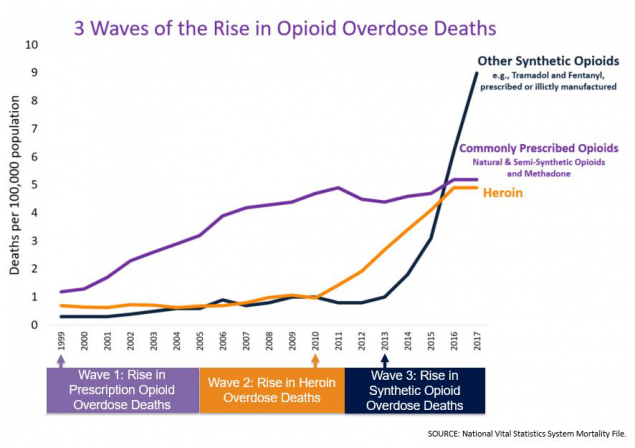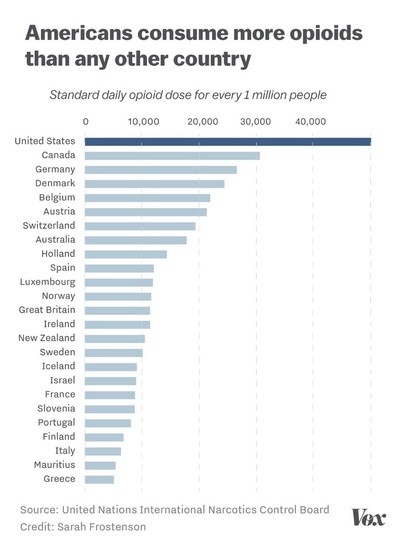Fentanyl is one of the most well-known synthetic opioids that has been in the spotlight lately—and not for good reasons. The World Drug Report 2019 reveals that there have been more than 47,000 opioid overdose deaths in the United States in 2017. This is an increase of 13% from the previous year. The same report also draws attention to the international severity of the crisis with regards to fentanyl and fentanyl analogs expanding to Europe and elsewhere. This is becoming a global epidemic.
Novel psychoactive substances (NPS) like fentanyl analogs are not naturally occurring substances. These drugs are designed to mimic the pharmacological effects of controlled substances and are known as designer drugs. One of the most pressing problems is their potency, which is fifty times greater than heroin. Just 2 milligrams can kill a person, and that’s what is driving the US overdose epidemic. In most instances, fentanyl is mixed with heroin and cocaine—leading to fatal drug overdoses.
The inexpensive and flexible production process of these substances is also concerning. It’s a dangerous game of cat and mouse. Illicit producers are quick to alter chemical structures to evade new laws and policies as they emerge. It’s important to note that while the analogs are often similar to fentanyl, they can go undetected because they are not part of routine testing. Law enforcement, medical professionals and forensic toxicologists are fighting to keep up.
Sadly, I can’t see any signs of this changing in the next decade. With consumer safety at risk, giving up the fight is not an option. As scientists, we need to prepare ourselves for what comes next. Information is key. So, let’s take a more in-depth look at the facts.
Fact #1: The opioid crisis is predicted to worsen
Preliminary data estimates that drug overdose deaths in the US declined by 5.1% in 2018. This sounds like great news as it appears that drug overdose deaths may have fallen for the first time since the crisis began in the 1990s.
A closer look, you’ll see that it needs some context. The decline doesn’t rule out the possible spread of fentanyl. It is more indicative of the falling painkiller overdose deaths, which went from around 15,000 in 2017 to below 13,000 in 2018. In fact, the same data will show overdose deaths linked to synthetic opioids, like fentanyl, went up from more than 29,000 in 2017 to nearly 32,000 in 2018.

Secondary source: CDC
So what does that mean? It means that fentanyl is known as the third wave of the opioid crisis, after the first wave of prescription opioids and the second wave of heroin. A study from the Massachusetts General Hospital (MGH) Institute for Technology Assessment predicts that the epidemic is likely to worsen.1 Under a status quo scenario, the model projects that the annual number of opioid overdose deaths will increase to 81,700 by 2025. Illicit opioids will represent 80% of these overdoses, with deaths predicted to reach 68,000 by 2025 (that’s a 260% increase over 10-years).

Secondary source: Vox
While Americans appear to consume more opioids than any other country, neighboring Canada seems to be facing similar challenges. According to the government, between January and March 2019, fentanyl and its analogs accounted for 82% of opioid-related deaths. That’s 716 deaths within the first three months of the year!
While opioids still account for the most substantial number of deaths, fentanyl and its analogs aren’t the leading culprit in Europe. Instead, heroin or its metabolites, often mixed with other substances, are a more significant concern. In 2017, there were 1,164 deaths in England and Wales involving heroin and morphine (which make up about 46% of all deaths from drug use). A similar situation exists in Australia, where morphine, codeine, oxycodone and heroin pose a greater threat.
Fact #2: Synthetic drugs are on the move
While these predictions are astounding, according to the RAND report on The Future of Fentanyl and Other Synthetic Opioids, the situation could worsen, especially if the drugs spread to other parts of the US. It concludes that the US synthetic opioid problem is not yet truly national in scope. Some regions have been acutely affected, while others have so far been spared, in relative terms.
Deaths have remained concentrated regionally in the eastern parts of the US, mainly due to drug trafficking networks. But synthetic opioids are on the move, and authorities west of the Mississippi River need to remain vigilant. Synthetic opioids are not absent from western states. Provisional data from authorities indicate a sharp increase in overdose fatalities or drug seizures involving fentanyl, as evidenced by the cases in San Francisco and Arizona.
What if the crisis becomes a national one? According to RAND, the math is simple and distressing. If the entire nation had a death rate of even half of what New England experienced in 2017, it would imply a substantial increase in deaths.
On the global front, the World Drug Report 2019 indicates there has been a shift in the synthetics market with a spike in demand for more potent drugs. For instance, the same report showed that Nigeria had a significant demand for the non-medical use of prescription opioids (mainly tramadol) in 2017.
Fact #3: Novel drugs continue to show up overnight
The scale of the situation is alarming, as is the pressure toxicology labs are under. If the rapid escalation of the problem wasn’t challenging enough, these novel designer drugs are also evading analysts through their chemistry.
Production is inexpensive and flexible. Every day, illicit producers cook up new versions of the drugs, each one a slightly different chemical structure or a new functional analog. This not only obstructs law enforcement but creates new risks for consumers and new problems for toxicologists. To put this into perspective, between 2009 and 2018, almost 900 novel psychoactive substances were reported to the UNODC Early Warning Advisory (EWA), with 130 reported in 2009 and 492 in 2018.
That’s nearly 10 a week!
Things are also complicated by the highly dynamic nature of modern drug consumption. With an increased number of drugs appearing on the market, consumers typically—knowingly or unknowingly—use several different substances. This is a direct result of street drugs being “cut” with a variety of different things. In fact, it is not uncommon for drug makers and drug dealers alike to add other drugs or non-intoxicating compounds to the product.
Adding other compounds is a way to increase volume, by hiding substances of similar appearance in the drug and passing it off as pure. It is a pressing concern as it increases the risk that potent new psychoactive substances, such as fentanyl derivatives, will miss detection when consumed with more established drugs like heroin. Fentanyl and other synthetic opioids have proven to be attractive cutting agents due to their low production cost and strong sedative properties.
Using cutting agents dramatically increases the risk of combined drug intoxication that could result in serious health complications and possibly death. This means that good forensic and toxicological data is vital to identify the presence of cutting agents and ensure that new health threats are identified.
Now that you have the facts, the question is: How can toxicology and forensic labs keep up?
Here is a common wish list that I tend to hear from scientists:
- A fast and reliable way to identify and characterize these substances. Speed and accuracy is key as rapid identification is critical to reverse opioid toxicity.2
- A sensitive method that can detect fentanyl in biological material at very low concentrations. In most instances, the concentration is no higher than several nanograms per milliliter or per gram. The drugs in these concentrations cannot be detected using routine screening procedures.
- A comprehensive approach that can keep up with the emergence of new or varying chemicals
Novel drugs of abuse will continue to present a challenge for analysts. We need to find ways to identify and characterize these substances while keeping up with the constant emergence of new or variant chemicals.
Alex Krotulski from the Center for Forensic Science Research & Education discusses his research to identify new and emerging illicit substances in this article. He also shares a rapid approach to report new NPS metabolites, using liquid chromatography high-resolution mass spectrometry (LC-HRMS) and MetabolitePilot™ Software. You can access his full study here.
In another interview with Technology Networks, Alex also discusses something that most toxicologists today can relate to—the race against the evolution of fentanyl variants. He shares an application note which describes a non-targeted screening workflow for identifying fentanyl analogs in forensic biological samples. You will get insight into a streamlined workflow using the X500R QTOF System in combination with the SCIEX OS Software Formula Finder feature and ChemSpider database searching.
If you’re looking for an all-in-one workflow to identify forensic analyte, I recommend learning more about the SCIEX Forensic Toxicology vMethod™.
Ultimately, the right tools might be the only defense law enforcement, medical professionals and forensic toxicologists have.
If you have questions on how mass spectrometry can help, SCIEX solutions, or need help, leave a comment here. You can also email me at pierre.negri@sciex.com.
References
- Chen, Qiushi, et al. “Prevention of Prescription Opioid Misuse and Projected Overdose Deaths in the United States.” JAMA Network Open, vol. 2, no. 2, Jan. 2019, doi:10.1001/jamanetworkopen.2018.7621.
- Nandakumar, Rajalakshmi, et al. “Opioid Overdose Detection Using Smartphones.” Science Translational Medicine, vol. 11, no. 474, Sept. 2019, doi:10.1126/scitranslmed.aau8914.






 Contact Support
Contact Support
0 Comments